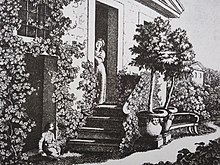Carl Wilhelm Lieber
Carl Wilhelm Lieber (born March 30, 1791 in Weimar ; † October 5, 1861 ibid) was a German draftsman, decoration and stage painter, restorer and landscape painter.
Life
Since 1813 he preferred to be a sub-teacher at the Free Drawing Institute in Weimar . Before that, the son of the Weimar valet Johann Christian Lieber (1757–1836) studied on Goethe's advice until 1812/13 in Dresden with Caspar David Friedrich and Georg Friedrich Kersting . 1805 Dear worked for the industry Comtoir country of Friedrich Justin Bertuch . So it is that Lieber's drawings can be found in the Journal of Luxury and Fashions . His son August Lieber was also a painter.
Work and action
For Carl Maria von Weber's opera Der Freischütz , which in 1821 Berlin was first performed, created Carl Wilhelm Holdermann (not for the first performance (!)) For the stage set the picture "The Wolf Canyon", but for the performance in 1822 in Weimar in aquatint by a drawing by Carl Wilhelm Lieber, which Carl August Schwerdgeburth added with figural staffage . Lieber himself was also involved in a collection of engravings and drawings based on Goethe's models. a. Wilhelm Holdermann had contributed and which was edited by Carl August Schwerdgeburth.
In a short note on April 23, 1815 , Friedrich Wilhelm Riemer mentions a Persian gold flower ornament by Lieber.
Lieber had also restored Goethe's house and seems to have been appreciated by Goethe for it too. This example may be highlighted : Karl Emil Helbig's diary entry from April 5, 1828 noted: All the pictures that Lieber restored are now in the secret council's room, and he is beginning to admire Lieber's talent and skill in restoration, yes he does visits lovers in his studio.
In 1827, Lieber received the most important restoration contract with the restoration of a work by Lucas Cranach , an ancestor of Goethe himself, in Weimar. Heinrich Meyer proposed him . With support u. a. von Meyer and Goethe and the Grand Duke Carl August Lieber learned how to restore paintings in Dresden . It was thought that Lieber would be able to work as a painting restorer for the Weimar collections. Lieber's mentor in the field of landscape painting in Dresden was Caspar David Friedrich, with whom he did not get along well and the relationship was soon ended. His mentor in the field of restoration was Pietro Palmaroli .
literature
- Hellmuth von Maltzahn : Dear, Karl (Carl) Wilhelm . In: Hans Vollmer (Hrsg.): General lexicon of fine artists from antiquity to the present . Founded by Ulrich Thieme and Felix Becker . tape 23 : Leitenstorfer – Mander . EA Seemann, Leipzig 1929, p. 179 .
Web links
Individual evidence
- ^ Gitta Günther , Wolfram Huschke , Walter Steiner (eds.): Weimar. Lexicon on city history. Hermann Böhlaus successor, Weimar 1998, p. 277.
- ↑ http://zfbb.thulb.uni-jena.de/receive/jportal_person_00038023
- ↑ Reproduced from Clive Brown, "Weber, Carl Maria [Friedrich Ernst] von", in: The New Grove Dictionary of Opera, ed. Stanley Sadie, in 4 vols., IV (Oxford: Grove, 1997), p. 1115.
- ↑ At noon with my wife, [the young] Kotzebue and Professor Hand at Goethe's. Liebers Persian gold floral ornament. , in: Goethe's Conversations Biedermann Edition , Vol. 2: Conversations of the years 1805–1817, ed. by Wolfgang Herwig, Munich 1998, p. 1004.
- ↑ Goethe's Conversations Biedermann Edition , Vol. 3.2: Conversations of the Years 1825–1832, ed. by Wolfgang Herwig, Munich 1998, p. 260.
- ↑ Volker Wahl: "" a miraculous building of happiness and wellbeing ". Goethe's last birthday letter to Grand Duke Carl August of September 3, 1827 , in: Goethe Jahrbuch: Volume 116/1999, pp. 345-352. Here p. 352.
- ↑ Xun He: The Classical Laocoon Discourse and its Impact on Contemporary Art Production up to the 19th Century: 1755–1872 , Dissertations of LMU Munich Vol. 33, Munich 2019, p. 105. digital
- ^ Gitta Günther , Wolfram Huschke , Walter Steiner (eds.): Weimar. Lexicon on city history. Hermann Böhlaus successor, Weimar 1998, p. 277.
| personal data | |
|---|---|
| SURNAME | Dear Carl Wilhelm |
| ALTERNATIVE NAMES | Dear Karl Wilhelm |
| BRIEF DESCRIPTION | German painter, draftsman and set designer |
| DATE OF BIRTH | March 30, 1791 |
| PLACE OF BIRTH | Weimar |
| DATE OF DEATH | October 5, 1861 |
| Place of death | Weimar |

